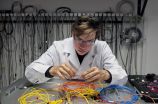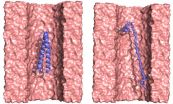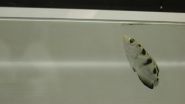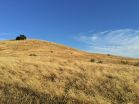(Press-News.org) Oxford, August 20, 2015 - Researchers in China have developed tiny nanocrystals that could be used in the next generation of medical imaging technologies to light up cancer cells. In a study published in the inaugural issue of the journal Applied Materials Today, a new rapid, online only publication, the team of researchers describe how they make these films which are based on the heavy metals lanthanum and europium.
Dr. Yaping Du of Xi'an Jiaotong University, China, and colleagues have developed a way to make high-quality nanocrystals of lanthanide oxybromides, where the lanthanide metal can be lanthanum, europium, gadolinium or terbium. They produce the materials by heating a readily available precursor material, which also allows them to incorporate triply charged europium ions, Eu3+, as "dopants" into any of the LaOBr nanocrystals.
In the study team explains that their process allows them to very precisely control the exact size and shape of the nanocrystals and it is this that allows them to fine tune the color of the light these materials produce when stimulated with ultraviolet light or electricity. Their tests with transmission electron microscopy on the nanocrystals, which form as ultrathin films, plates and tiny particles, reveal the desired quality and uniformity. X-ray crystallography and ultraviolet spectroscopy provide additional detailed evidence about the internal structure of the nanocrystals at the atomic level.
Once they had established the chemical and physical details about the nanocrystals, the team then tested the particles as "staining" agents on a tissue sample containing liver cancer cells held on a microscope slide. They found that these diseased cells could take up the nanocrystals, whereas healthy cells do not; they preferentially "stain" the cancer cells, which can clearly be seen under the microscope through their bright luminescence. Such targeting and ease of identification of cancer cells could allow oncologists to spot even tiny numbers of diseased cells in a biopsy sample.
The team also suggests that the bright luminescence of their lanthanide oxybromides might also be used in low-energy lighting applications as an alternative to compact fluorescent bulbs and light emitting diodes (LEDs).
"The results reported by Du et al could have significant impact on the fields of nanomaterials for medical imaging and lighting," says Prof Manish Chhowalla of Rutgers University, and Editor-in-Chief of Applied Materials Today. "We are pleased that the authors have chosen Applied Materials Today to publish their work; since its launch several months ago the journal has received very high quality papers for review and hope to see this trend continue."
INFORMATION:
Notes for editors
"Synthesis of High-Quality Lanthanide Oxybromides Nanocrystals with Single-Source Precursor for Promising Applications in Cancer Cells Imaging" by Dong Yan; Bo Lei; Bo Chen; Xuejun Wu; Zhengqing Liu; Na Li; Juan Ge; Yumeng Xue; Yaping Du, Ph.D; Zhiping Zheng; Hua Zhang. It is published online in Applied Materials Today.
http://www.materialstoday.com/biomaterials/features/synthesis-of-lanthanide-oxybromides-nanocrystals/
http://www.sciencedirect.com/science/article/pii/S2352940715000025
Copies of the paper are freely available on registration via the Materials Today website.
http://www.sciencedirect.com/science/article/pii/S2352940715000025
About Materials Today
Materials Today is a community dedicated to the creation and sharing of materials science knowledge and experience. Supported by Elsevier, we publish high impact peer-reviewed journals, organize academic conferences, broadcast educational webinars and so much more.
About Elsevier
Elsevier is a world-leading provider of information solutions that enhance the performance of science, health, and technology professionals, empowering them to make better decisions, deliver better care, and sometimes make groundbreaking discoveries that advance the boundaries of knowledge and human progress. Elsevier provides web-based, digital solutions -- among them ScienceDirect, Scopus, Elsevier Research Intelligence and ClinicalKey-- and publishes over 2,500 journals, including The Lancet and Cell, and more than 33,000 book titles, including a number of iconic reference works. Elsevier is part of RELX Group plc, a world-leading provider of information solutions for professional customers across industries. http://www.elsevier.com
NEW YORK, NY - Patients with scoliosis who undergo surgery may be less likely to develop an infection or other complications after the procedure when a novel wound closure technique pioneered at NYU Langone Medical Center is utilized, according to new research. The study was published online this past July in the Journal of Pediatric Orthopaedics.
In this new technique, surgeons use a multilayered flap closure that enables doctors to close several layers of muscle and fascia while maintaining blood supply from the donor site to the recipient site. The researchers believe ...
Post-discharge disease management provided in their own homes could be a cost-effective alternative for recently-hospitalised elderly patients with chronic heart failure (CHF).
Just published in the International Journal of Cardiology, this is the finding of a recent economic evaluation conducted by Griffith University using data from a randomised controlled trial (The WHICH Study).
In collaboration with the Australian Catholic University, 280 patients with CHF recruited from three public hospitals, received multidisciplinary disease management.
With the aim of reducing ...
The solid waste left over from wine-making could make a competitive biofuel, University of Adelaide researchers have found.
Published in the journal Bioresource Technology, the researchers showed that up to 400 litres of bioethanol could be produced by fermentation of a tonne of grape marc (the leftover skins, stalks and seeds from wine-making).
Global wine production leaves an estimated 13 million tonnes of grape marc waste each year. Nationally it is estimated that several hundred thousand tonnes are generated annually and it is generally disposed of at a cost to ...
The problem has been that the vast majority of these atomically thin 2D crystals are unstable in air, so react and decompose before their properties can be determined and their potential applications investigated.
Writing in Nano Letters, the University of Manchester team demonstrate how tailored fabrication methods can make these previously inaccessible materials useful.
By protecting the new reactive crystals with more stable 2D materials, such as graphene, via computer control in a specially designed inert gas chamber environments, these materials can be successfully ...
In the Arctic, warming increases like a spiral. Global warming means that the periods of growth are becoming longer and vegetation growth is increasing. At the same time, heat transfer to the Arctic from lower latitudes is rising, reducing sea ice there, and this in turn is contributing towards a faster local rise in temperature.
A new research study published in the highly respected research journal PNAS shows that the situation is the reverse on the Tibetan Plateau.
Vegetation on the Tibetan Plateau has also increased as a result of global warming. However, in contrast ...
A team at the University of Warsaw, Faculty of Physics has created a laser capable of generating ultrashort pulses of light even under extremely difficult external conditions. This unique combination of precision and resilience is due to the fact that the whole process of generating femtosecond laser pulses takes place within a specially-selected optical fiber.
Its appearance seems quite inconspicuous: just a flat, rectangular box, tens of centimeters across and about the same height, with a thin, shiny-tipped "thread" leading out of it, so long that it is rolled up ...
University of Pennsylvania researchers have made strides toward a new method of gene sequencing a strand of DNA's bases are read as they are threaded through a nanoscopic hole.
In a new study, they have shown that this technique can also be applied to proteins as way to learn more about their structure.
Existing methods for this kind of analysis are labor intensive, typically entailing the collection of large quantities of the protein. They also often require modifying the protein, limiting these methods' usefulness for understanding the protein's behavior in its natural ...
Move over, Katniss Everdeen. For archerfish, the odds are ever in their favor, according to new research from Wake Forest University.
The sharp-shooting fish's ability to spit water to hit food targets has been well documented, but a new study published online in the journal Zoology showed for the first time that there is little difference in the amount of force of their water jets based on target distance. And, when given the choice, the fish preferred closer targets.
The study was co-authored by Wake Forest researchers Morgan Burnette, a biology graduate student, ...
A new study says that global warming has measurably worsened the ongoing California drought. While scientists largely agree that natural weather variations have caused a lack of rain, an emerging consensus says that rising temperatures may be making things worse by driving moisture from plants and soil into the air. The new study is the first to estimate how much worse: as much as a quarter. The findings suggest that within a few decades, continually increasing temperatures and resulting moisture losses will push California into even more persistent aridity. The study appears ...
COLUMBUS, Ohio - Formula One racing teams may have a lesson to teach business leaders: Innovation can be overrated.
That's the conclusion from academic researchers who pored over data from 49 teams over the course of 30 years of Formula One racing. They found that the teams that innovated the most - especially those that made the most radical changes in their cars - weren't usually the most successful on the race course.
Moreover, radical innovations were the least successful at exactly the times when many business leaders would be most likely to try them: when there ...



